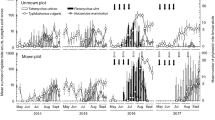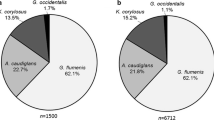Abstract
We sampled mites in three apple orchards in Nova Scotia, Canada, that had been inoculated with pyrethroid-resistant Typhlodromus pyri and had a history of Tetranychus urticae outbreaks. The objective of this study was to monitor populations of T. urticae and phytoseiid predators on the ground and in trees and to track dispersal between the two habitats. Pesticides were the chief cause of differences in mite dynamics between orchards. In two orchards, application of favourably selective acaricides (abamectin, clofentezine) in 2002, coupled with predation by T. pyri in trees and Neoseiulus fallacis in ground cover, decreased high T. urticae counts and suppressed Panonychus ulmi. By 2003 phytoseiids kept the tetranychids at low levels. In a third orchard, application of pyrethroids (cypermethrin, lambda-cyhalothrin), plus an unfavourably selective acaricide (pyridaben) in 2003, suppressed phytoseiids, allowing exponential increases of T. urticae in the ground cover and in tree canopies. By 2004 however, increasing numbers of T. pyri and application of clofentezine strongly reduced densities of T. urticae in tree canopies despite high numbers crawling up from the ground cover. Another influence on T. urticae dynamics was the distribution of the phytoseiids, T. pyri and N. fallacis. When harsh pesticides were avoided, T. pyri were numerous in tree canopies. Conversely, only a few N. fallacis were found there, even when they were present in the ground cover and on tree trunks. Low numbers were sometimes due to pyrethroid applications or to scarcity of prey. Another factor was likely the abundance of T. pyri, which not only competes with N. fallacis, but also feeds on its larvae and nymphs. The scarcity of a specialist predator of spider mites in trees means that control of T. urticae largely depends on T. pyri, a generalist predator that is not particularly effective in regulating T. urticae.







Similar content being viewed by others
References
Alston DG (1994) Effect of apple orchard floor vegetation on density and dispersal of phytophagous and predaceous mites in Utah. Agric Ecosys Environ 50:73–84
Bostanian NJ, Belanger A, Rivard I (1985) Residues of four synthetic pyrethroids and azinphos-methyl on apple foliage and their toxicity to Amblyseius fallacis (Acari: Phytoseiidae). Can Entomol 117:143–152
Bostanian NJ, Thistlewood H, Racette G (1998) Effects of five fungicides used in Quebec apple orchards on Amblyseius fallacis (Garman) (Phytoseiidae: Acari). J Hort Sci Biotechnol 73:527–530
Chant DA, Hansell RIC (1971) The genus Amblyseius (Acarina: Phytoseiidae) in Canada and Alaska. Can J Zool 49:703–758
Chant DA, Hansell RIC, Yoshida E (1974) The genus Typhlodromus Scheuten (Acarina: Phytoseiidae) in Canada and Alaska. Can J Zool 52:1265–1291
Croft BA, MacRae IV (1992) Biological control of apple mites by mixed populations of Metaseiulus occidentalis (Nesbitt) and Typhlodromus pyri Scheuten (Acari: Phytoseiidae). Environ Entomol 21:202–209
Franklin JL, Hardman JM, Moreau DL (2002) Efficacy of a novel summer acaricide against two-spotted spider mites and European red mites on apple in 2001. 2001 Pest Management Research Report, Agriculture and Agri-Food Canada, Ottawa, pp 2–3
Genini M (1987) Écosystème verger du pommier: possibilités d’implantation des phytoséiides et modélisations du sous-système “verger-Panonychus ulmi (Koch)- Typhlodromus pyri (Scheuten)”. Dissertation, L’École Polytechnique Fédérale, Zürich
Gerson U, Cohen E (1989) Resurgences of spider mites (Acari: Tetranychidae) induced by synthetic pyrethroids. Exp Appl Acarol 6:29–46
Grafton-Cardwell EE, Hoy MA (1983) Comparitive toxicity of avermectin B1 to the predator Metaseiulus occidentalis (Nesbitt) (Acari: Phytoseiidae) and the spider mites Tetranychus urticae Koch and Panonychus ulmi (Koch) (Acari: Tetranychidae). J Econ Entomol 76:1216–1220
Hardman JM (1999) Biological and chemical mite control to increase fruit size. In: 135th Annual Report Nova Scotia Fruitgrowers’ Association, 1998. NSFGA, Kentville, NS, Canada, pp 62–70
Hardman JM, Gaul SO (1990) Mixtures of Bacillus thuringiensis and pyrethroids control winter moth (Lepidoptera: Geometridae) in orchards without causing outbreaks of mites. J Econ Entomol 83:920–937
Hardman JM, Rogers MA (1998) New opportunities for mite control in Nova Scotian apple orchards. In: 134th Annual Report of the N.S. Fruitgrowers’ Association 1997, NSFGA, Kentville, NS, Canada, pp 24–29
Hardman JM, Rogers REL, Nyrop JP, Frisch T (1991) Effect of pesticide applications on abundance of European red mite (Acari: Tetranychidae) and Typhlodromus pyri (Acari: Phytoseiidae) in Nova Scotian apple orchards. J Econ Entomol 84:570–580
Hardman JM, Rogers ML, Gaul SO, Bent ED (1997) Insectary rearing and initial testing in Canada of an organophosphate/pyrethroid-resistant strain of the predator mite Typhlodromus pyri (Acari: Phytoseiidae) from New Zealand. Environ Entomol 26:1424–1436
Hardman JM, Moreau DL, Snyder M, Gaul SO, Bent ED (2000) Performance of a pyrethroid resistant strain of the predator mite Typhlodromus pyri (Acari: Phytoseiidae) under different insecticide regimes. J Econ Entomol 93:590–604
Hardman JM, Franklin JL, Little K, Mahar A (2002) Efficacy of a novel summer acaricide against two-spotted spider mites and European red mites on apple in 2000. 2001 Pest Management Research Report, Agriculture and Agri-Food Canada, Ottawa, pp 23–25
Hardman JM, Jensen KIN, Franklin JL, Moreau DL, Bostanian NJ (2003) An index for selective toxicity of acaricides to phytophagous mites and their predators based on orchard trials. Pest Manage Sci 59:1321–1332
Hardman JM, Jensen KIN, Franklin JL, Moreau DL (2005) Effects of dispersal, predators (Acari: Phytoseiidae), weather, and ground cover treatments on populations of Tetranychus urticae (Acari: Tetranychidae) in apple orchards. J Econ Entomol 98:862–874
Hardman JM, Franklin JL, Jensen KIN, Moreau DL (2006) Effects of pesticides on mite predators (Acari: Phytoseiidae) and colonization of apple trees by Tetranychus urticae (Acari: Tetranychidae). Phytoparasitica 34:449–462
Henderson CF, McBurnie HV (1943) Sampling techniques for determining populations of the citrus red mite and its predators. U.S. Dept Agric Circ 671
Herbert HJ (1981) Biology, life tables and innate capacity for increase of the two-spotted spider mite Tetranychus urticae (Acarina: Tetranychidae). Can Entomol 113:371–378
Hislop RG, Prokopy RJ (1981) Integrated management of phytophagous mites in Massachusetts (U.S.A.) apple orchards. 2. Influence of pesticides on the predator Amblyseius fallacis (Acarina: Phytoseiidae) under laboratory and field conditions. Prot Ecol 3:157–172
Johnson DT, Croft BA (1981) Dispersal of Amblyseius fallacis (Acarina: Phytoseiidae) in an apple ecosystem. Environ Entomol 10:313–319
Kimura Y, Kushita T (1994) Susceptibility of Panonychus ulmi (Koch) and Tetranychus urticae Koch (Acari: tetranychidae) to three acaricides in Aomori Prefecture. Ann Rep Soc Plant Prot North Japan 45:195–197
Lasnier J, Bostanian NJ, Trudeau M, Racette G (2004) Biological control of phytophagous mites in apple orchards. St. Lawrence Action Plan, Ministère d’Agriculture, Pêcheries et Alimentation de Québec and Agriculture and Agri-Food Canada Leaflet. Publication 04–0011
Lester P (1998) An assessment of the predator Amblyseius fallacis for biological control of the European red mite. Dissertation, Queen’s University, Kingston, Ontario, Canada
Li SY, Harmsen R (1992) Effects of low application rates of the pyrethroid PP-321 on the apple orchard mite complex (Acari) in Ontario. Can Entomol 124:381–390
McMurtry JA, Croft BA (1997) Life-styles of phytoseiid mites and their roles in biological control. Annu Rev Entomol 42:291–321
Meagher RL, Meyer RH (1990) Influence of ground cover and herbicide treatments on Tetranychus urticae populations in peach orchards. Exp Appl Acarol 9:149–158
Meyer RH (1974) Management of phytophagous and predatory mites in Illinois orchards. Environ Entomol 3:333–340
Nyrop JP (1988) Spatial dynamics of an acarine predator–prey system: Typhlodromus pyri (Acarina: Phytoseiidae) preying on Panonychus ulmi (Acarina: Tetranychidae). Environ Entomol 17:771–778
Nyrop JP, Minns JC, Herring CP (1994) Influence of ground cover on dynamics of Amblyseius fallacis Garman (Acarina; Phytoseiidae) in New York apple orchards. Agric Ecosys Environ 50:61–72
Nyrop J, English-Loeb G, Roda A (1998) Conservation biological control of spider mites in perennial cropping systems. In: Barbosa P (ed) Conservation biological control. Academic Press, New York
Pratt PD, Schausberger P, Croft BA (1999) Prey-food types of Neoseiulus fallacis (Acari: Phytoseiidae) and literature versus experimentally derived prey-food estimates for five phytoseiid species. Exp Appl Acarol 23:551–565
Sabelis MW (1985) Predation on spider mites. In: Helle W, Sabelis MS (eds) Spider mites. Their biology, natural enemies and control, vol 1B. Elsevier, Amsterdam
SAS Institute (1994) SAS/STAT user’s guide, vol 2. SAS Institute, Cary, North Carolina
Schausberger P (2003) Cannibalism among phytoseiids: a review. Exp Appl Acarol 29:173–191
Westigard PH, Lombard PB, Berry DW (1967) Bionomics and control of the two-spotted spider mite on pear in southern Oregon. Oregon Agric Res Sta Bull 101:32 pp
Yoo SS, Kim SS (2000) Comparitive toxicity of some pesticides to the predatory mite, Phytoseiulus persimilis (Acarina: Phytoseiidae) and the two-spotted spider mite, Tetranychus urticae (Acarina: Tetranychidae). Korean J Entomol 30:235–241
Zacharda M (1989) Seasonal history of Typhlodromus pyri (Acari:Mesostigmata: Phytoseiidae) in a commercial apple orchard in Czechoslovakia. Exp Appl Acarol 6:307–325
Acknowledgments
We thank Debbie Moreau, Gaye Sponagle and our summer students, Rebecca Hildebrand and Sarah Outerleys, for technical assistance and the apple growers, Andrew Bishop, Gerry Van Oostrum and Lisa Jeneraux, who collaborated in this project. This study was supported by grants received from the Matching Investments Initiative of Agriculture and Agri-Food Canada (Project No. A02512) and the Technology Development Program of the Nova Scotia Department of Agriculture and Fisheries (Project DEV20-072). This paper is contribution number 2343 of the Atlantic Food and Horticulture Research Centre, Kentville, Nova Scotia, Canada.
Author information
Authors and Affiliations
Corresponding author
Additional information
The Canadian Crown's right to retain a non-exclusive, royalty-free licence in and to any copyright is acknowledged.
Rights and permissions
About this article
Cite this article
Hardman, J.M., Franklin, J.L., Beaulieu, F. et al. Effects of acaricides, pyrethroids and predator distributions on populations of Tetranychus urticae in apple orchards. Exp Appl Acarol 43, 235–253 (2007). https://doi.org/10.1007/s10493-007-9117-7
Received:
Accepted:
Published:
Issue Date:
DOI: https://doi.org/10.1007/s10493-007-9117-7




